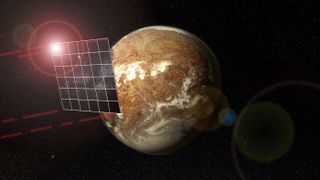- UID
- 20
- Online time
- Hours
- Posts
- Reg time
- 24-8-2017
- Last login
- 1-1-1970
|
|
━━━━━━━━━━━━━━━━━

(Image: © Planetary Habitability Laboratory, Univesity of Puerto Rico at Arecibo)
▼ Interstellar space travel. Fantasy of every five-year-old kid within us. Staple of science fiction serials. Boldly going where nobody has gone before in a really fantastic way. As we grow ever more advanced with our rockets and space probes, the question arises: could we ever hope to colonize the stars? Or, barring that far-flung dream, can we at least send space probes to alien planets, letting them tell us what they see?
The truth is that interstellar travel and exploration is technically possible. There's no law of physics that outright forbids it. But that doesn't necessarily make it easy, and it certainly doesn't mean we'll achieve it in our lifetimes, let alone this century. Interstellar space travel is a real pain in the neck.
Voyage outward
If you're sufficiently patient, then we've already achieved interstellar exploration status. We have several spacecraft on escape trajectories, meaning they're leaving the solar system and they are never coming back. NASA's Pioneer missions, the Voyager missions, and most recently New Horizonshave all started their long outward journeys. The Voyagers especially are now considered outside the solar system, as defined as the region where the solar wind emanating from the sun gives way to general galactic background particles and dust.
So, great; we have interstellar space probes currently in operation. Except the problem is that they're going nowhere really fast. Each one of these intrepid interstellar explorers is traveling at tens of thousands of miles per hour, which sounds pretty fast. They're not headed in the direction of any particular star, because their missions were designed to explore planets inside the solar system. But if any of these spacecraft were headed to our nearest neighbor, Proxima Centauri, just barely 4 light-years away, they would reach it in about 80,000 years.
I don't know about you, but I don't think NASA budgets for those kinds of timelines. Also, by the time these probes reach anywhere halfway interesting, their nuclear batterieswill be long dead, and just be useless hunks of metal hurtling through the void. Which is a sort of success, if you think about it: It's not like our ancestors were able to accomplish such feats as tossing random junk between the stars, but it's probably also not exactly what you imagined interstellar space travel to be like.
Speed racer
To make interstellar spaceflight more reasonable, a probe has to go really fast. On the order of at least one-tenth the speed of light. At that speed, spacecraft could reach Proxima Centauri in a handful of decades, and send back pictures a few years later, well within a human lifetime. Is it really so unreasonable to ask that the same person who starts the mission gets to finish it? (▪ ▪ ▪)
► Please, continue reading this article here: Source |
|